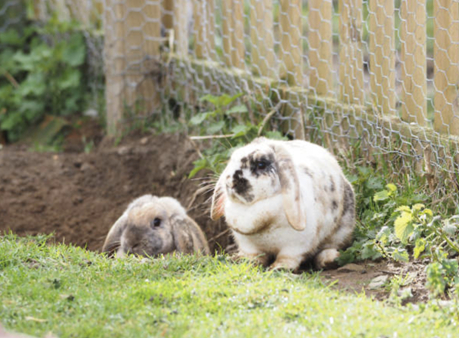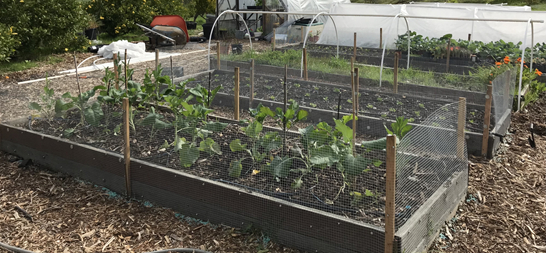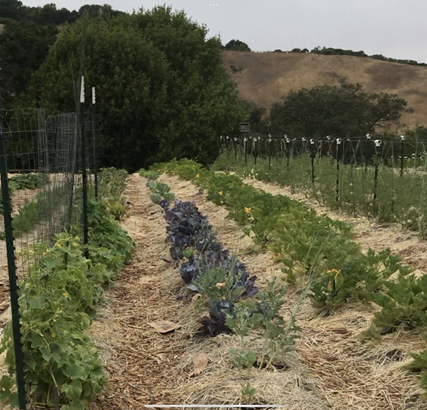
Home >> Newsletters > GreenFriends Newsletters > > Q2 2023 Newsletter
| Home | Source Reduction | Friends of Green Friends | Newsletters |
| Gardening | Resources | What You Can Do | Embracing The Trees |
| Managing Invaders and Pests in the Garden |
 Rabbits can dig under fences |
|
"What It is the duty of human beings to serve and take care of Nature. In return, Nature will return all the good." - Amma We always like to encourage other creatures to enjoy the gardens here at MA Center San Ramon, and to share the harvest with them, in moderation, of course. For the most part, we are comfortable losing the occasional apple, tomato or pepper to a hungry bug, bird or squirrel, however, when the creatures become a nuisance and do not practice discretion (.ie. wasting fruit with just one bite!), then they need to be managed. To help you identify what animal is taken to eating excessively in your garden, you can use this helpful resource from the University of California.In the M.A. Center garden beds, we have wrapped each bed with wire mesh fencing, about 3 feet above the ground, and this helps keep rabbits out. Each bed is also lined with mesh on the bottom to deter burrowing animals such as voles and gophers. So far, this technique has proven effective in deterring these mammals. |
 Raised beds wrapped in heavy mesh at the M.A. Center in San Ramon |
|
To deter birds, we tried lightweight mesh over the plants, but this became perilous for the birds, so we immediately removed them. In the orchards, we hung old CD’s from the branches of the trees as the shiny, spinning motion in the wind was an effective deterrent for birds. This also worked well in the vegetable beds, particularly on the tomato vines. The most distressing pest we have experienced in our garden are rats. They are tenacious, can climb over the raised bed fences, and have proven to be quite wasteful in their foraging. Grinding up bars of Irish Spring soap and scattering it around the outside edges of the raised bed deterred some rat activity, but we still lost a lot of vegetables. This year, we will be proactive with planting lots of mint in pots inside the beds (to control the spread of mint) and hope this acts as another deterrent. Fortunately, it seems this year a weasel mother and babies have moved into the area of the vegetable garden, so we are hopeful they will greatly diminish our resident rat population. |
 California weasel |
|
A note on live traps: in California it is illegal in urban areas (such as ours) to trap an animal and then release it in another location without a specific permit. So purchasing live traps, catching your problem squirrel, then releasing it in a park nearby is highly illegal. The best thing to do, if you have a severe problem with mammal pests, is to wrap your entire raised bed in wire mesh, sides and cover. The only other option is to contact your local pest control, but understand that they will likely euthanize captured animals. Also, chances are others may still find their way to your garden. Before you consider purchasing live traps, make sure it is legal to do so in your state or county.
InsectsOne of the best ways to discourage insect pests is to encourage beneficial birds and insects into your garden! You can plant certain companion plants to encourage these beneficial creatures to move into your garden, and you can even purchase insects, such as lady beetles, and have them shipped to your home. Here is a helpful article on how to attract beneficial critters into your garden. |
 Ladybug laying eggs with nymph |
|
Another effective way of reducing the amount of damaging insects in your garden is keeping it clear of debris and well aerated. Decomposing leaf litter on the ground, thick bush plants lacking aeration, dark and damp areas all encourage detrimental pests to move in and thrive. So pruning, keeping your garden clean and free of debris is essential, along with promoting good aeration among the plants. This will also help prevent bacterial diseases in your plants. If all these fail, you can try applying a mix of neem oil and biodegradable dish soap to spray on your infested plants. This will also help heal and deter pathogenic diseases on your plants. Neem oil is a potent fungicide that can help with diseases on vegetable plants like powdery mildew (common on zucchini for example).That being said, science has recently found that some bees can be moderately affected by neem oil, so use with caution, especially during bloom season. Here are a couple of common vegetable plant diseases and their solutions: Powdery Mildew - this is a fungal disease that affects some vegetable plants, especially in the squash family, such as cucumbers and zucchini. It looks like the leaves have been dusted in white powder. To solve this, you need to remove the most affected leaves altogether and discard with your compostable garbage, not in your compost pile. Then you can spray neem oil mix directly on the remaining leaves preventatively. Blossom End Rot - this is in fact not an infection, but an abiotic disorder. The most common cause for this is a calcium deficiency, mostly combined with fluctuating weather and temperature patterns. To remedy this, you can add a natural calcium supplement like limestone powder or bone meal. Make sure you do not give the plants other fertilizers while treating as these will compete with the calcium for plant nutrient uptake. Blossom end rot can affect tomatoes, peppers, eggplant, squashes and melons. Similar to humans and animals, plants can become immune-compromised under certain conditions. Damp, litter-full gardens with little aeration definitely can negatively affect plants, as these conditions are perfect for harmful bacteria to move in. Poor soil with only few beneficial microorganisms can also impact plant immunity, as can stress. To improve plant immunity, you can use foliar sprays of compost tea. You can also ensure the soil is healthy by applying clean organic compost regularly to encourage beneficial microorganisms to thrive in your soil, thus supporting plant growth and immunity. Amma also says we should communicate lovingly with our plants as they too can sense emotions, and this can be a mood-lifting exercise for us as well! |
 A well-aerated garden at M.A. Center San Ramon |
|
The best step in plant maintenance is just to walk around your garden daily or at least a few times a week, inspect each plant, look under the bottom leaves for pests or signs of disease, look at the health of the plants and their fruit. Prune back heavy foliage to allow for aeration between the plants, and make sure plant branches and leaves are off the ground. If you see something that doesn’t look right, here is a robust, science-based online diagnostic tool from University of California Agriculture and Natural Resources to help you diagnose plant diseases and their recommended solutions.
Wishing you a happy and fruitful summer gardening experience! |
| Amartya, California |
Read an Embracing the Trees Update: Earth Day in Toronto in the Q2 2023 Newsletter >>
| Home | Source Reduction | Friends of Green Friends | Newsletters | Resources | What You Can Do | Contact Us |
For more information, e-mail info@greenfriendsna.org |
||||||